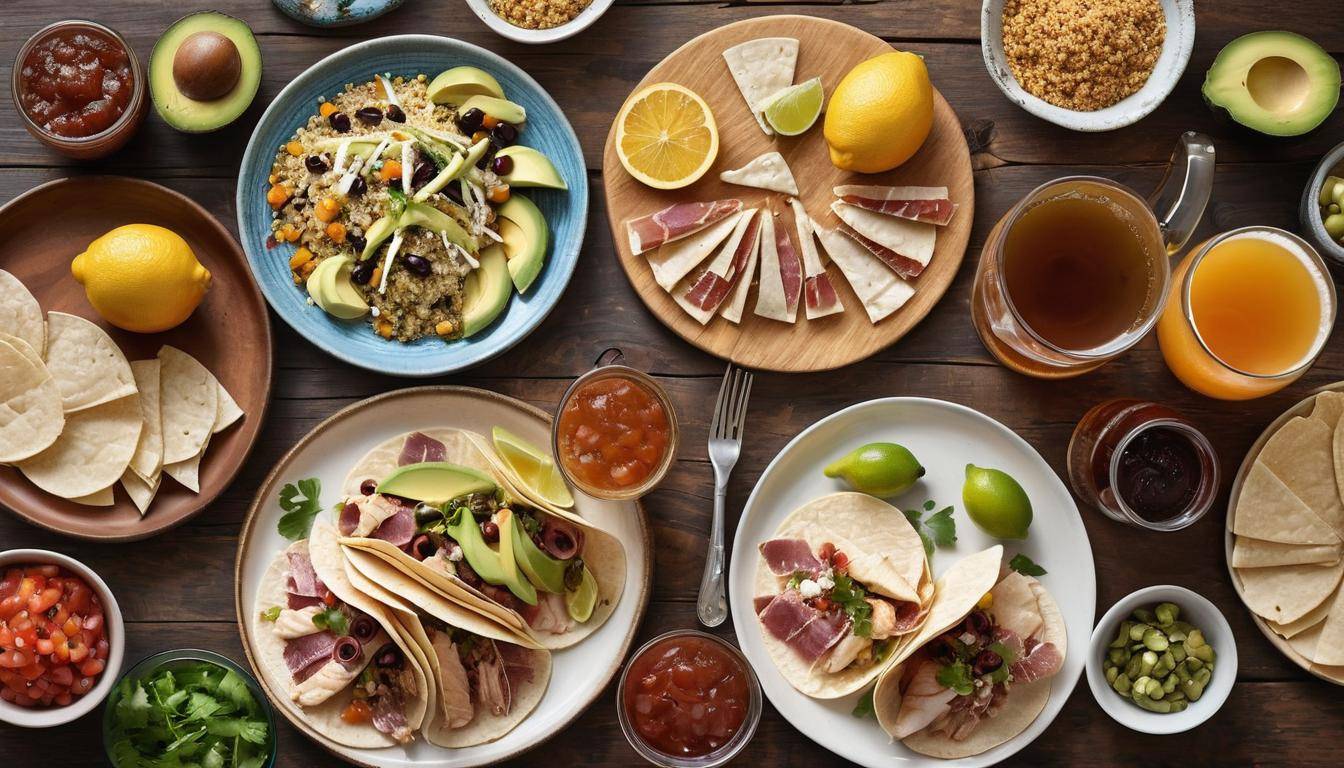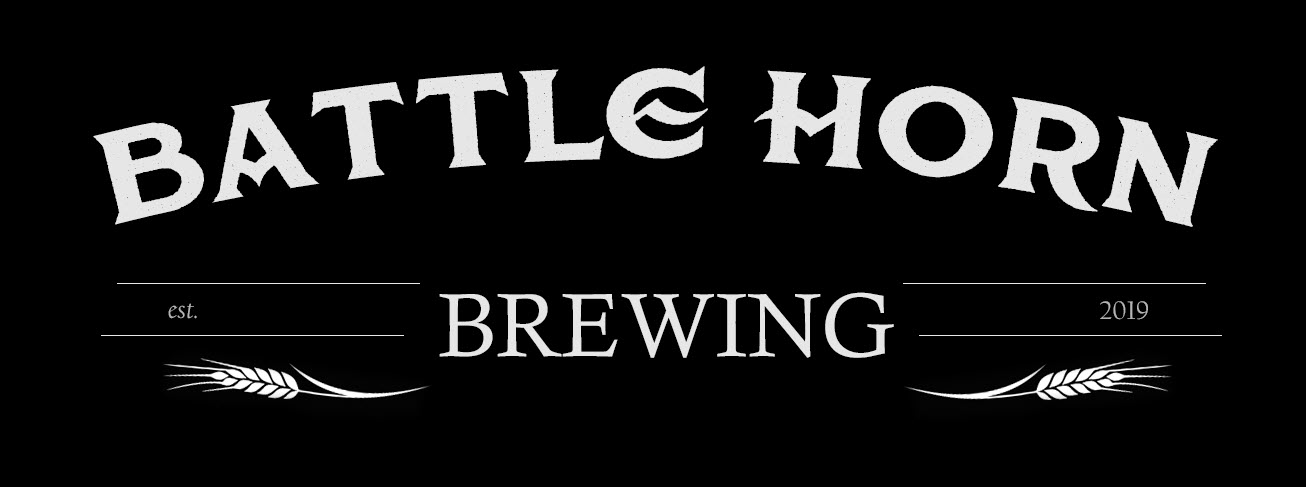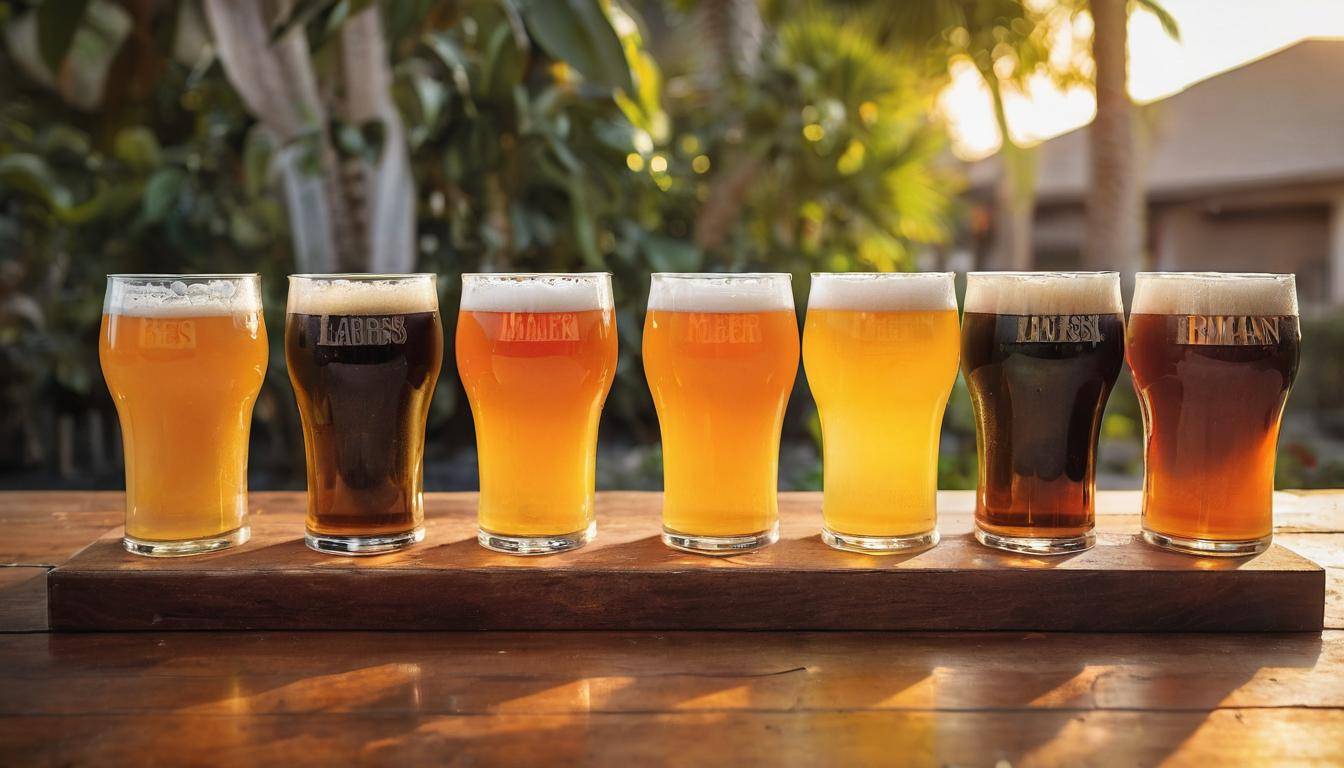
Imagine taking that first refreshing sip of a zesty beer on a warm summer’s afternoon, with hints of lemon zest and orange peel dancing on your palate. Citrus beers, known for their fruity freshness, have become a staple in craft beer brewing and are gaining popularity among aficionados looking for something unique. The lively aroma and bright flavored beer make them perfect companions for social gatherings or solo unwinding after a long day.
From traditional Radlers to modern Citrus IPAs packed with hops that burst with natural citrus notes, there’s much to discover in citrus flavored beer.
Citrus beer refers to a style of craft beer that incorporates flavors from citrus fruits such as lemons, limes, oranges, or grapefruits, enhancing its refreshing taste profile. This style can include various types of beers like shandies and radlers, often characterized by lower alcohol content and an easy-drinking nature due to the balance between sweetness and acidity from the added citrus ingredients.
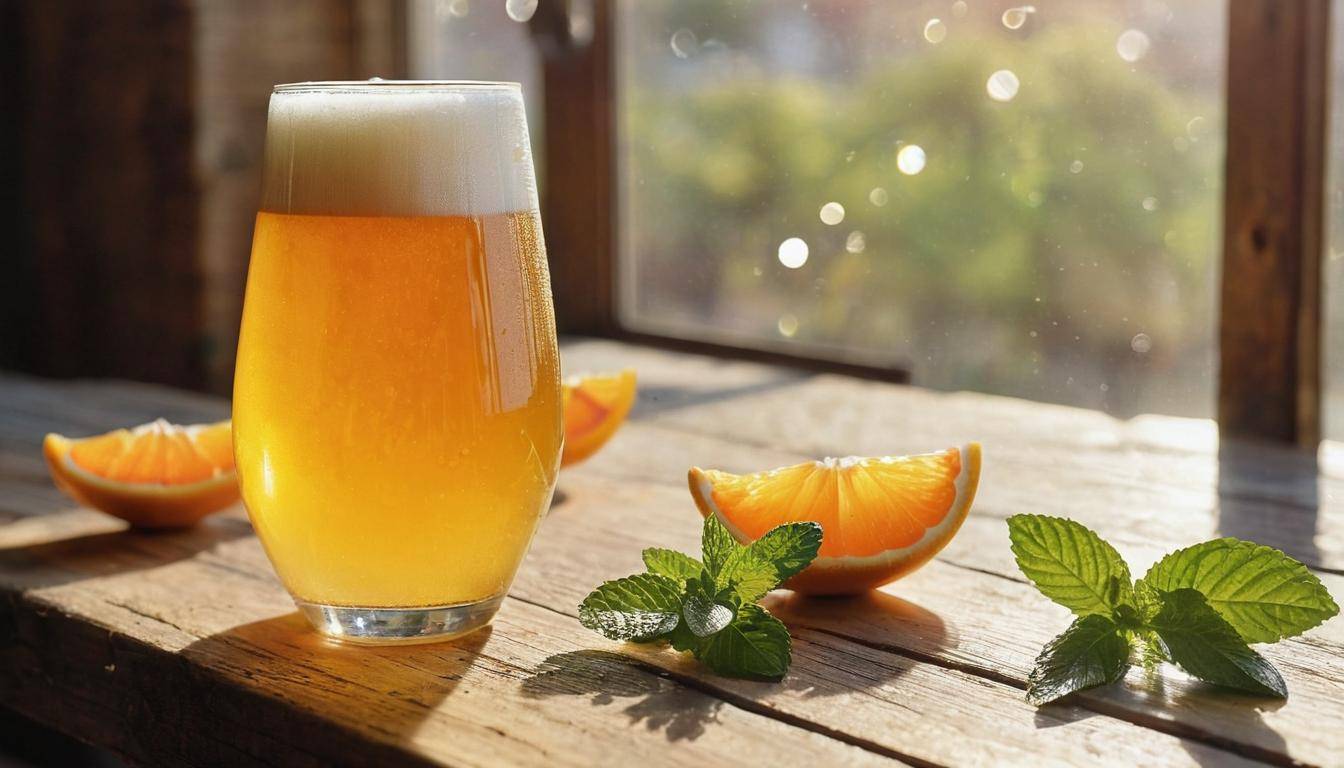
What is Citrus Beer?
Citrus beer is a delightful fusion that introduces the invigorating essence of citrus fruits into the world of brewing. Think about the zest of a fresh lemon or the sweet juiciness of an orange; these elements can be coaxed into the brew in various ways, be it through the use of zest, juice, or certain hop varieties that naturally bring forth these bright flavors. The rise in popularity of citrus beers within craft breweries stems from consumers’ growing desire for beverages that are both refreshing and multifaceted. They’re searching for something that quenches thirst while also offering an intricate balance and depth that good brewing practices deliver.
The inclusion of citrus can uplift a beer’s profile. A well-crafted citrus beer doesn’t just taste fruity; it incorporates layers of flavor that can transform every sip into an experience worth savoring. For instance, carefully selected hops such as Citra and Cascade impart their natural citrus characteristics, creating a harmonious blend with any added juices or peels. One wouldn’t be surprised to find a citrus beer where a creative brewer skillfully marries the zesty and sweet notes of citrus with the robust maltiness expected in a classic beer.
Different Styles of Citrus Flavored Beer
Let’s look at some popular styles that exemplify what citrus beer can offer:
- Radlers: Often seen as a refreshing option, radlers combine beer with lemonade or lemon-lime soda. Their lower alcohol content makes them particularly appealing during warm weather or outdoor activities, hence earning their name from the German word “radler,” meaning “cyclist.” It’s no surprise these light concoctions are favored after a long ride.
- Shandies: A close cousin to radlers, shandies typically mix beer with citrus-flavored soft drinks or juices. While common in English-speaking regions, they embody the same spirit—providing a thirst-quenching beverage that balances sweetness with malt.
- Citrus IPAs: These India Pale Ales enhance traditional hoppy bitterness by layering in citrus elements from selected hops. Sip on one and relish not just an IPA but a citrus beer experience that elevates its fundamental bitterness with a citrusy flourish.Here, the bitterness mingles beautifully with zesty notes from added citrus peels or juices, inviting hop lovers on a unique journey through flavor profiles. The diverse offerings of citrus beers provide a refreshing experience for everyone, provided they meet the legal drinking age.
- Wheat Beers: With their naturally light and slightly sweet base, wheat beers create an ideal canvas for citrus additions. The subtlety of the wheat allows lemon or lime flavor to shine without overpowering other essential characteristics of the brew. For those of legal drinking age, these citrus-infused wheat beers offer a delightful blend of flavors that can enhance any social gathering.
Craft brewers across the globe are experimenting with inventive ways to incorporate citrus fruits into their recipes, leading to unique synergies between flavors. Among these are citrus beers that are gaining a dedicated following among adults looking for innovative taste experiences.
The citrus beer approach to brewing, it’s fascinating to trace back the origins and historical context behind this vibrant drink. The evolution of citrus beers reflects the creativity and experimentation of brewers intent on pleasing a mature palate.
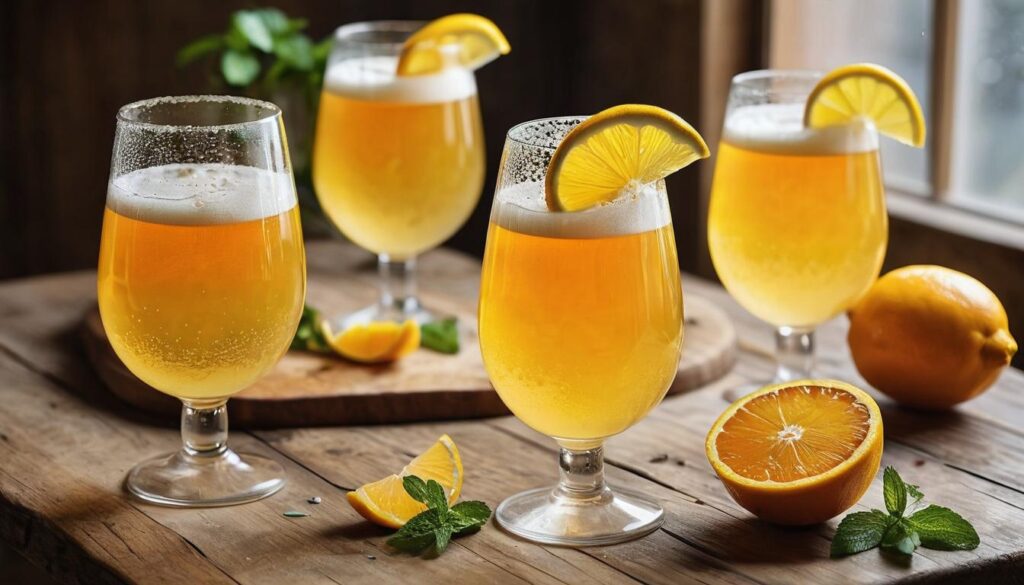
Citrus Beer History and Origins
The history of citrus beer is a tale of innovative minds reacting to their surroundings. It all began in Europe, where climate, geography, and the accessibility of certain fruits influenced the development of refreshing brews. Germany and Britain stand out as pivotal players in this narrative, each contributing unique beverages that made use of bright citrus flavors.
German Radlers
The advent of the Radler is one notable milestone in this story. This drink’s origin can be traced back to 1922 when German innkeeper Franz Kugler sought to quench the thirst of weary cyclists. Legend has it that on a hot day, he mixed a light lager with lemonade to create a deliciously refreshing drink. This simple act sparked an enduring trend—a perfect beverage for those biking through the scenic German countryside. The word radler, derived from radlermass, literally translates to “cyclist liter,” emphasizing its role as a hydrator for those on two wheels. Those of drinking age could enjoy this refreshing mix responsibly while savoring the balance of flavors.
The clever blend not only provided hydration but also moderated alcohol content, making it ideal for enjoyment post-ride without compromising safety. It’s a wonderful drink option for those at or above the drinking age who want to enjoy a light yet flavorful beverage.
Over the years, Radlers have evolved substantially, with breweries experimenting by adding various citrus fruits and other mixers to amplify their flavor profiles. Interestingly, this consummate pairing continues to thrive in both local beer gardens and contemporary craft breweries worldwide. For many adults, the addition of new ingredients keeps the tradition interesting and aligned with modern preferences.
British Shandies
While Germany played a crucial role in introducing lightened beers like Radlers, Britain was simultaneously brewing its own take on refreshing drinks—Shandies.
Emerging in the 19th century, British shandies originally involved mixing ale with ginger ale or lemonade, providing a sweet yet zesty contrast that made it a favorite among drinkers looking for something lighter. These concoctions started as homemade refreshments before becoming widely popular as commercial products. One significant entry into the market was Leinenkugel’s Summer Shandy launched in 2007, which ushered shandies into mainstream popularity once more. Today, shandies continue to satisfy those of legal drinking age with their distinctive, refreshing characteristics, particularly during sunny seasons.
This revival transformed these mixes into sought-after beverages during warm weather months and helped solidify their place within the craft beer landscape. The appeal of citrus beers, including Radlers and Shandies, lies in their ability to cater to a mature audience searching for both tradition and innovation in their imbibing experiences.
As we explore these roots in German and British brewing practices, it becomes clear why certain ingredients were embraced and celebrated within citrus beers—the balance of sweetness from malted barley combined with the tartness of lemons or oranges resonates well with consumers seeking flavorful yet crisp options. These beverages remain a staple for adventurous adults who appreciate the nuanced craft of citrus-infused beers.
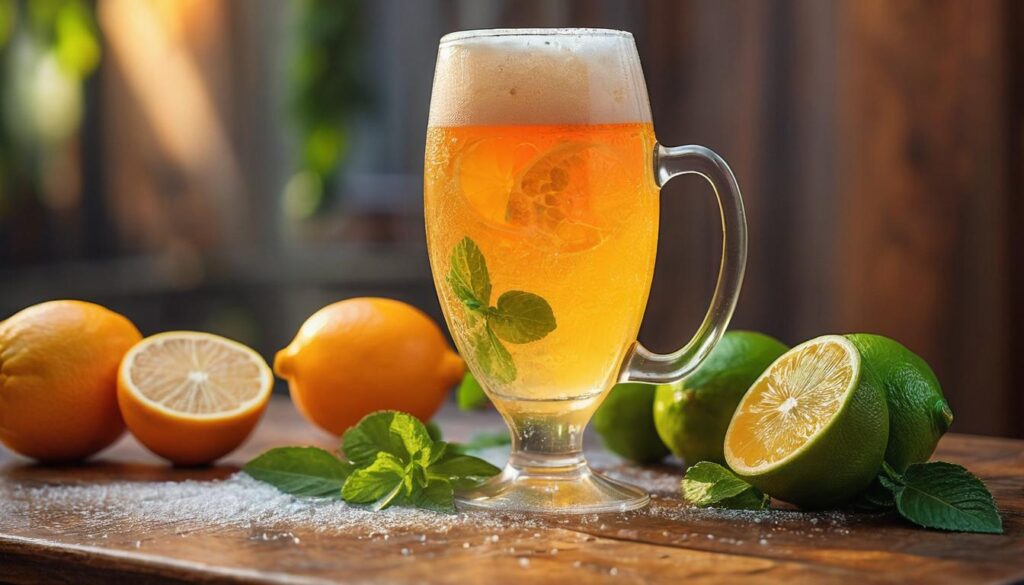
Understanding these historical influences on citrus beer styles sets the stage for examining the elements that define citrus beers today. The allure of these flavorful concoctions continues to captivate, provided one meets the appropriate drinking age to responsibly enjoy the nuanced and vibrant flavors they offer. The importance of key ingredients in citrus beer cannot be overstated; they create vibrant flavors and enhance the overall drinking experience. Fresh citrus fruits impart much of the delightful taste and aroma that many have come to love. Fresh citrus fruits, such as lemons, limes, oranges, and grapefruits, are often used for their zest or juice. The quantity and type selected can significantly influence both the acidity and freshness of the final product. For instance, using zesty lemons might introduce a refreshing sharpness, while oranges could lend a more mellow sweetness, creating a balance that excites the palate. Moreover, the fermentation process plays a crucial role in developing the distinctive flavors of citrus beer, transforming sugars into alcohol and carbonation.
Key Ingredients in Citrus Beers
Fresh citrus fruits are like a burst of sunshine in every sip, bringing brightness and a unique tanginess to citrus beers. As new beer releases in cans continue to gain popularity, brewers often capitalize on this trend by offering citrus beers that capture the spirit of summer in a portable and refreshing form.
Citrus Fruits
When choosing citrus fruits for brewing, experimentation is key. Homebrewers share their triumphs of utilizing different combinations—the moderate use of zest can elevate flavor complexity, laying down an aromatic foundation that dances on the taste buds. Zest releases essential oils that enhance aroma without contributing excessive acidity. So imagine your favorite summer day; a well-crafted citrus beer can transport you right back there with each taste.
While fruits infuse flavor, hops take center stage in defining bitterness and aroma.
Hops play an equally critical role in the construction of citrus beers. Varieties such as Citra, Cascade, and Amarillo stand out for their naturally citrus-forward profiles. These hops contribute not only to the bitterness but also add complementary citrus notes that mesh beautifully with the fruit components. According to the National Institute of Hops, it’s fascinating that Citra hops contain high levels of myrcene oil—an organic compound responsible for captivating citrus aromas. This characteristic makes them popular among craft brewers looking to emphasize fruitiness over malty sweetness.
Hops Used in Citrus Beer
Balancing hops is essential in this process; achieving harmony rather than letting any one element overpower the others is key. With subtle bitterness from hops and fresh tang from citrus fruits working together, can you imagine sipping on one on a warm afternoon?
Of course, no beer would be complete without its backbone—malts.
In the context of citrus beers, light malts generally take precedence. They allow fruity flavors to shine through unencumbered by dense malt characteristics found in darker brews. Wheat malts are notably popular in shandies and wheat beers because they provide a softer mouthfeel and add a measure of creaminess without overwhelming the bright notes of fruit. This provides an ideal canvas for brewing refreshing beverages.
Malts Used in Brewing
When preparing your own batch or selecting from local breweries, keep an eye out for lighter malts if you’d like the fruity essence to take precedence over any roasted or caramel-like notes.
These key ingredients invite unique beer styles when mixing flavors at home or enjoying artisanal brewing creations; it lays the groundwork for appreciating the nuances that come into play with each beer sip.
The flavor profiles of citrus beers offer ranges of tastes that combine various characteristics to create unique drinking experiences. The careful orchestration of fermentation, hops, and citrus elements ensures each sip offers a refreshing burst of flavor.
Citrus Flavor Profiles and Aromas
Citrus Beer Flavor Profiles
A lemon-based shandy hits your palate with a refreshing acidity, tinged with sweetness that brings a pleasant zing. By exploring different beer releases in cans, enthusiasts can enjoy diverse flavor adventures wherever they go.In contrast, a grapefruit-infused beer presents a bold tang that can be both bitter and refreshing, appealing to those who enjoy a more intense flavor. The sweetness perceived in an orange-infused wheat beer can soften this acidity, rounding out a flavor that feels juicy yet balanced. At a local brewery, you might find these citrus-infused beers served with just the right amount of carbonation, ensuring every pint has a refreshing effervescence.
In addition to individual fruit characteristics, the interplay of hops and malts can deepen the complexity of flavors within these brews. Hops with distinct sweet notes can enhance the natural fruitiness of oranges or tangerines, making the final product feel more layered and sophisticated. On the other hand, using darker malts might introduce chocolate or caramel notes—an intriguing combination when balanced with citrus fruits.
As for aromas, they often serve as a precursor to the tasting experience. The scent wafting from your glass is usually a mosaic of fragrance drawn from the expressed oils of their ingredients.
Aromas of Citrus
Imagine taking a deep breath and catching notes of fresh citrus peel, inviting you into its essence—a sensory experience that heightens anticipation. Citrus beers commonly exhibit floral undertones alongside hints of various fruits, allowing for an aromatic journey that complements the flavors beautifully.
The aroma profile plays a pivotal role in your first impression, setting the stage for what’s to come. A grapefruit IPA might greet you with sharpness—a fragrant burst that feels alive and invigorating. By contrast, an orange wheat beer will likely embrace you with its warm, inviting sweetness reminiscent of blooming flowers on a sunny day.
You’ll encounter some citrus beers that evoke memories or feelings through their aroma alone—like how a sip of lemon shandy can remind you of sunshine at a summer picnic or an orange-infused lager may take you back to lazy afternoons by the beach, as you enjoy the perfect carbonation level with each pint.
Understanding these orange, lime or lemon flavor profiles and aromas enriches your experience; this knowledge serves as guidance as you begin exploring citrus beer options in greater detail. With this foundation laid, you’ll be primed to discover some standout selections worth seeking out.
Exploring citrus beers can be exciting, especially when you taste how these unique flavors blend into different beer styles.
Top Citrus Beers to Sample

Leinenkugel’s Summer Shandy: A quintessential summer beer, this classic shandy balances its 4.2% ABV with a bright lemon flavor and gentle sweetness that makes it ideal for warm days spent lounging outdoors. The light finish invites you back for another sip, making it a favorite at summer barbecues or picnics.
Popular Picks for Commercial Citrus Beers
- Stiegl Radler Grapefruit: If you find yourself craving something sessionable, this Radler from Austria is perfect. With only 2.5% ABV, it offers a delightful grapefruit zing that is not too overbearing. It’s wonderfully refreshing and pairs well with lighter fare like salads or grilled fish, providing a crisp counterpoint to their flavors.
- Ballast Point Grapefruit Sculpin: For those looking for more complexity, this IPA delivers in spades. At 7% ABV, it features bold grapefruit notes that harmonize beautifully with its characteristic hoppy bitterness. This beer elevates a range of dishes, particularly spicy tacos or rich cheeses as it cuts through the richness and enhances overall flavor.
- Blue Moon LightSky Citrus Wheat: This option caters to those who prefer something less intense but still flavorful. Featuring tangerine accents in a light-bodied wheat ale, it’s an effortless choice for casual gatherings or relaxing evenings at home. Its smooth profile complements everything from soft pretzels to fruity desserts.
Citrus beers are a refreshing option for those who enjoy drinking craft beer in taprooms or at their favorite brewing company. These beers are often crafted by artisans, with a focus on combining yeast, malts, and hops to create balanced flavors. During beer tastings, blind-tasted brews reveal citrusy notes from ingredients like orange peels, blood orange, grapefruit, tangerine, mango, and key lime. The zesty citrus zest and fruit juice blend with the bitterness of hops such as Amarillo and Citra, offering a wide range of beer styles, from crisp IPAs and hazy IPAs to smooth wheat beer and radlers. Whether you’re sipping a shandy, a radler, or a traditional ale, the aromas of lemon and lime add a bright twist. Wit beer, amber ales, and even lemonade-inspired beers with low alcohol by volume (ABV) and moderate International Bitterness Units (IBU) are popular in taprooms. As you sip on these brews, you’ll taste a variety of flavors, including malt sweetness and hop bitterness, depending on the style. From a fruity shandy to a more hop-forward IPA, citrus beers continue to innovate in brewing, giving fans a unique, refreshing experience at every brewery.
